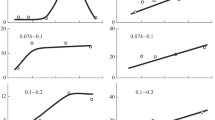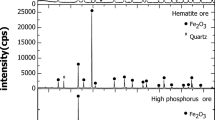Abstract
Batches hematite particles were reduced to magnetite by hydrogen in small scale fluidized bed, from which samples of partially reduced ore could be extracted for metallographic studies or surface area measurements. A stabilized zirconia cell was used to monitor the gas phase composition at eight locations in the bed. With this device a complete picture of the consumption of hydrogen was established that could detect small changes in the efficiency of the reduction reaction. Approximate rates of reduction could also be calculated. Hematite reduction took place in three stages; an initial period in which the efficiency of the reaction increased with time, followed by a period of relatively constant reduction efficiency, and finally after about 85 to 90 pct transformation a period of falling efficiency. Wustite did not form while hematite was present. The efficiency of the reaction increased when the hematite particles were coated with platinum and decreased when the particles were coated either with silica or with a naturally occurring dirt film. A kinetic and morphological analysis indicated that the reaction was rate controlled by a surface reaction at the bottom of pores in the magnetite. These pores do not appear to penetrate to the receding hematite interface. The initial increase in the efficiency of the reaction was attributed to the developing pore structure of the magnetite which increased the area for reaction.
Similar content being viewed by others
Reference
J. S. Sheasby and J. F. Gransden:Can. Met. Q., 1974, vol. 13, pp. 479–84.
J. S. Sheasby and J. F. Gransden:Met.-Slag-Gas React. Processes, [Pap. Int. Symp.], Z. A. Foroulis and W. W. Smeltzer, eds., pp. 226–37, Electrochem. Soc, Inc., Princeton, NJ, 1975.
J. R. Porter and P. R. Swann:Ironmaking Steelmaking, 1977, vol. 4, no. 5, pp. 300–07.
P. R. Swann and N. J. Tighe:Met. Trans. B, 1977, vol. 8B, pp. 479–87.
G. Nabi and W. K. Lu:Trans. TMS-AIME, 1968, vol. 242, pp. 2471–77.
G. Nabi: Ph.D. Thesis, McMaster Univ., Hamilton, Ontario, Canada, 1973.
P. C. Hayes:Met. Trans. B, 1979, vol. 10B, pp. 211–17.
H. Brill-Edwards, B. L. Daniell, and R. L. Samuel:J. Iron Steel Inst., vol. 203, pp. 361–68.
E. T. Turkdogan:Met. Trans. B, 1978, vol. 9B, pp. 163–79.
C. Y. Wen:Ind. Eng. Chem., 1968, vol. 60, no. 9, pp. 34–54.
R. H. Spitzer, F. S. Manning, and W. O. Philbrook:Trans. TMS-AIME, 1966, vol. 236, pp. 726–42.
O. Levenspiel:Chemical Reaction Engineering, p. 311, John Wiley and Sons, New York, 1972.
F. M. Nelson and F. T. Eggertsen:Anal. Chem., 1958, vol. 30, pp. 1387–90.
I. Barin and O. Knacke:Thermochemical Properties of Inorganic Substances, Springer-Verlag, New York, 1973.
D. Caplan, G. I. Sproule, R. J. Hussey, and M. J. Graham:Oxid. Met., 1978, vol. 12, pp. 67–82.
J. F. Richardson and J. Sezekely:Trans. Inst. Chem. Eng., 1961, vol. 39, pp. 212–22.
C. N. Satterfield and T. M. Sherwood:The Role of Diffusion in Catalysis, pp. 5–28, Addison Wesley Publishing Co., New York, 1963.
E. T. Turkdogan, R. G. Olsson, and J. V. Vinters:Met. Trans., 1971, vol. 2, pp. 3189–96.
D. Caplan: private communication, N.R.C., Ottawa, Canada.
C. Wagner:Acta Metall., 1969, vol. 17, pp. 99–107.
S. E. Khalafalla, G. W. Reimers, and M. J. Baird:Met. Trans., 1974, vol. 5, pp. 1013–18.
G. Subat and J.-J. Engell:Tech. Mitt. Krupp, Forschungsber., 1968, vol. 26, pp. 117–24.
E. I. Turkdogan and J. V. Vinters:Can. Met. Q., 1973, vol. 12, pp. 9–21.
G. H. Geiger and J. B. Wagner, Jr.:Trans. TMS-AIME, 1965, vol. 233, pp. 2092–2100.
Author information
Authors and Affiliations
Rights and permissions
About this article
Cite this article
Srinivasan, M.V., Sheasby, J.S. A study of the reduction of hematite to magnetite using a stabilized zirconia cell. Metall Trans B 12, 177–185 (1981). https://doi.org/10.1007/BF02674771
Received:
Issue Date:
DOI: https://doi.org/10.1007/BF02674771




